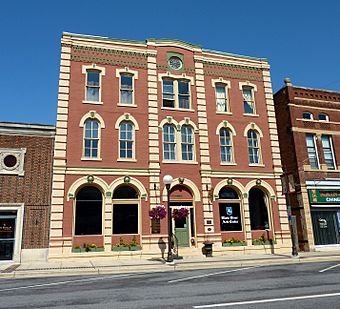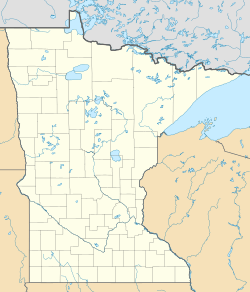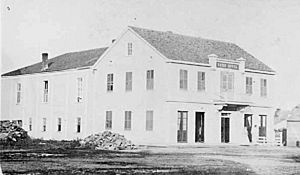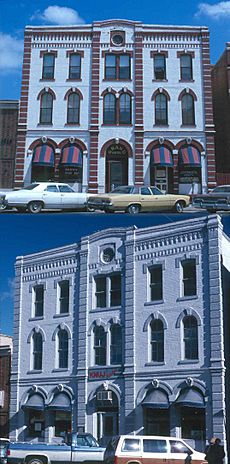Grand Hotel (New Ulm, Minnesota) facts for kids
Quick facts for kids |
|
|
Grand Hotel
|
|
 |
|
| Location | 210 N. Minnesota St., New Ulm, Minnesota |
|---|---|
| Area | less than one acre |
| Built | 1876 |
| Architect | Julius Berndt |
| Architectural style | Italianate |
| NRHP reference No. | 90000986 |
| Added to NRHP | June 21, 1990 |
The Grand Hotel is a historic building in New Ulm, Minnesota, United States. It used to be a hotel. This special building was added to the National Register of Historic Places on June 21, 1990. It's important because it shows how New Ulm's businesses grew. It's also a great example of the Italianate architecture style used for a business building.
Contents
What Does the Grand Hotel Look Like?
The Grand Hotel is a three-story building made of brick. It's built in the Italianate style. You can find it right in the middle of New Ulm's old business area. When it first opened in 1876, it was called the Union Hotel and only had two stories. In 1899, new owners added the third floor. They also updated the heating, plumbing, and lights. A brick addition was built at the back. After these changes, they renamed it the Grand Hotel.
The Front of the Building
The front of the hotel faces south towards the street. It has three main sections, separated by flat columns called pilasters. The middle section is a bit narrower than the other two. The windows on each floor look different.
On the first floor, there's a main entrance in the middle. It has a window above the door (a transom) and windows on the sides (sidelights). Large, paired plate glass windows are on either side of the entrance. All five openings on the first floor have rounded brick arches. Each window has a fancy decoration called a cartouche at the top, like a special keystone. In the middle of the arched doorway, you can see a carved lion's head. The building's balanced Italianate design is highlighted by the brick corners, known as quoins. A decorative brick band, called a corbel table, separates the first and second floors.
The second floor has six identical windows. These are double hung windows, meaning both parts can slide up and down. They have stone sills at the bottom and raised brick arches with keystones at the top. The two windows in the very center are paired together. You can still see parts of a cornice (a decorative molding) just above the keystones on this floor.
The top floor windows are similar to the second floor's, but they are simpler. They have almost flat brick arches with keystones. Above these windows, there's a row of decorative bricks that look like teeth, called dentils. A large round window is in the center of the front wall. More decorative bricks form a fancy top edge for the building. The roof is gently sloped, and each wall has a low protective wall called a parapet at the top.
Sides and Back
The west side of the building has five windows on the third floor. The east side has eight windows on the first floor, seven on the second, and six on the third. All these windows have stone sills and rounded brick arches. At the back of the building, there's a one-story brick addition from 1899 with a skillion roof (a roof with a single slope).
Changes Over Time
The outside of the building hasn't changed much since the 1899 redesign, except for some repainting and the removal of awnings. In 1970, the building was sandblasted to clean it. In 1987, the brickwork was repaired (this is called tuckpointing), and a new roof and fire sprinkler system were added. The building has since been repainted to look like it did in the late 1800s.
History of the Grand Hotel
After special agreements were made with local Native American tribes in 1851, the Minnesota River Valley became open for new settlers. In 1854, the first big group of settlers arrived in Brown County, Minnesota. These were German immigrants from Chicago who wanted to start their own community. New Ulm was planned out in 1855. Soon, other German groups joined them. New Ulm was designed to be a center for trade and farming. Unlike many towns, it wasn't planned around a railroad. Instead, it relied on steamboats on the Minnesota River until the 1870s.
Early Hotels and Phillip Gross
By 1860, New Ulm had 635 people, almost all of German background. One of these people was Phillip H. Gross. He was born in Germany in 1809 and was a baker. He came to the United States in 1854. In 1856, he moved to New Ulm and opened a hotel.
His first hotel was a two-story wood-frame building called the Minnesota Haus. It was the only place in town where visitors could find room and board. Business was good! The hotel burned down in 1860, but Gross quickly rebuilt it. He made it bigger and renamed it the Union Hotel.
The Union Hotel became a very important place in New Ulm. During the Dakota War of 1862, when New Ulm was attacked, the hotel was used as a hospital. Over 185 buildings in the city were burned. One of the doctors at the hospital was William Worrall Mayo, who later started the famous Mayo Clinic in Rochester, Minnesota.
After the war, more settlers came to the area because of the Homestead Acts, which offered land. New Ulm began to grow, producing and selling farm products. When the railroad arrived in 1872, New Ulm became a major regional center. The Union Hotel was doing very well, but it was destroyed by another fire on July 5, 1875. The fire started in a barn next to the hotel and spread.
The Grand Hotel is Built
Phillip Gross immediately rebuilt the hotel as a two-story brick building. He hired an architect named Julius Berndt, who also designed the famous Hermann Heights Monument. Gross ran the hotel until he retired in 1885. His son-in-law, Wenzel Schotzko, then took over.
By 1884, two other hotels had opened in New Ulm. In 1899, a new owner of the Union Hotel added the third floor and made many updates. This is when the hotel got its current look and was renamed the Grand Hotel. It had thirty sleeping rooms, an office, a new kitchen, and a large dining room. Because of these changes, the Grand Hotel remained an important part of downtown New Ulm for many years.
Over time, the building stopped being a hotel. It had different owners and was used for various things. In 1970, it became a boarding house. In the 1990s, it housed a coffee shop, an art gallery, and a radio station. The third floor was empty. In 2000, Anne Makepeace, a great-great-granddaughter of Philip Gross, bought the building with her family. In 2003, they started restoring it to look like it did in the late 1800s. Today, it has a restaurant called the Grand Kabaret and some shops.
Why the Grand Hotel is Important
The Grand Hotel is important for a few reasons. First, it played a big part in the growth of New Ulm's business area. This business district was very important for the economy of the southern Minnesota River Valley in the late 1800s and early 1900s.
Second, the hotel is a great example of Italianate architecture for a business building. It's one of the best and most original examples of this style from the mid-Victorian period in New Ulm. While there are other larger buildings in New Ulm with more details, many of them were built later and have had their street-level fronts changed a lot. This means that no other building in the downtown area has kept its original historic look as well as the Grand Hotel.





